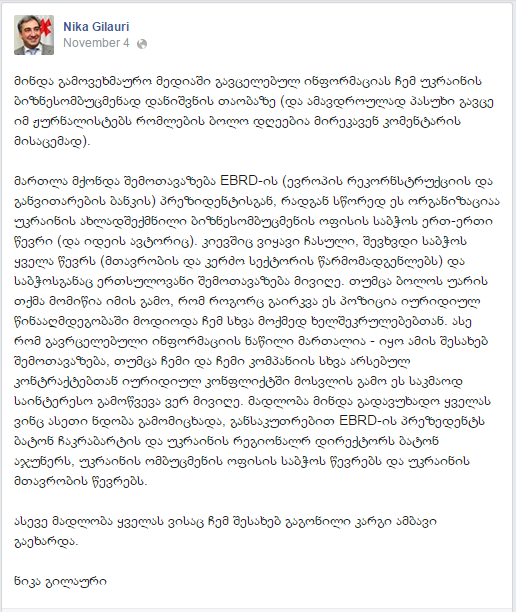On 14 November, during the plenary session of the Parliament of Georgia, Minister of Finance of Georgia, Nodar Khaduri, stated: “From 2014’s parameters, I want to point out the increase in export. Export has significantly increased. Export with the EU countries has increased by 23%. As for CIS countries, the decrease in export in this case is mainly due to the new regulations which concerned the export of motorcars from Georgia to these countries.”
FactCheck took interest in the Minister’s statement and verified its accuracy.
According to the June-September data of 2014, Georgia’s export volume amounted to USD 2,153 million. Export increased by 6.7% as compared to the same period of the last year. We analysed the dynamics of the increase in export in the same period (January-September) of the previous years. According to the nine-month data from 2011-2013, for example, the export increase rate was much higher than in the same period of 2014.
Source: National Statistics Office of Georgia
The 6.7% increase in the first three quarters of 2014 is mainly due to Russia (104% increase). Without the Russian market, the data of the first three quarters of 2014 would have increased only by 1.3%.
Of note is that the export volume of the third quarter decreased by 6.2% as compared to the same quarter of the last year. The export-oriented economic growth is extremely important for a small market such as Georgia. The only important increase according to the nine-month data of 2014 occurs in the Russian market. The risk of Russia closing its market to Georgia owing to political motivations remains a consideration (see FactCheck’s article).
Mr Khaduri also pointed out the increase in the export to EU countries. In January-September of 2014, the export to EU countries grew by 23% as compared to the respective data of the last year and amounted to USD 458 million. The export to CIS countries increased only by 1% and totalled USD 1,128 million. Of note is that the export to EU countries decreased by USD 28 million in the third quarter of this year.
Based upon the three-quarter data of 2014, the share of the CIS countries in the gross export is 52% whilst the share of the EU countries amounts to 21%. In the same period of 2013, CIS countries shared 56% of the gross export whilst EU countries shared 18.5%. Therefore, based upon the three-quarter data of this year, the share of CIS countries in the gross export has decreased whilst the share of EU countries has increased. Of note is that the export volume to EU countries is 2.5 times less than the export volume to CIS countries.
The export volume with Azerbaijan, as Georgia’s largest trading partner, has decreased significantly. According to the nine-month data of 2013, production valued at USD 529 million was exported to Azerbaijan whilst in the same period of 2014 this amounted to USD 426 million. As Mr Khaduri says, the decrease in the export to CIS countries was mainly due to the decrease in motorcar export which in turn was caused by new motorcar import regulations in place in Azerbaijan. According to the data of the National Statistics Office of Georgia, the main reason for the decreased export to Azerbaijan was indeed the decrease in motorcar export. In total, export to Azerbaijan decreased by USD 103 million in 2014 with USD 96 million of this amount comprising revenues from motorcar export.
According to the nine-month data of 2014, motorcar export amounted to USD 409 million. In the last year, this rate was equal to USD 512 million. Motorcar export had been constantly on the rise in recent years but has decreased significantly according to the nine-month data of 2014. Azerbaijan, Armenia and Central Asian countries are the main markets for motorcar export from Georgia.
The main reason for the decrease in motorcar export is the adoption of the Euro-4 Standard in Azerbaijan and Kazakhstan’s becoming a member of the Eurasian Union. To explain further, Azerbaijan enacted the Euro-4 Standard on 1 April 2014 which prohibits the import of motorcars manufactured earlier than 2005. Kazakhstan’s entry into the Eurasian Union obliges it to comply with the Union’s common tariff system which means that the clearance price for motorcars increased by nearly seven times. On 9 October 2014, Armenia agreed to join the Eurasian Union as well. It will ratify the document on 1 January 2015. Therefore, there is an expectation that motorcar export to Armenia will also decrease (FactCheck has previously written on this topic).
Conclusion
According to the January-September data of 2014, Georgia’s export increased by 6.7% as compared to the same period of the last year. Although, the export increase rate went down. In addition, according to the data of the last months (the third quarter of 2014), export volume decreased by 6.2% as compared to the same period of the last year. Therefore, it is incorrect to speak about a significant export increase against this background.
It should also be noted that the 6.7% increase in January-September was mainly due to the export increase to Russia. Without the Russian market, export in the first three quarters of 2014 would have increased only by 1.3%. The decrease recorded in the third quarter would have been even greater without the Russian market.
Nodar Khaduri is correct in pointing out the increase in export to the countries of the EU. He is also correct when he identifies the decrease in motorcar export connected with the newly imposed regulations in Azerbaijan and Kazakhstan’s entry into the Eurasian Union.
Interestingly enough, 2014’s third quarter data which show the decrease in export were already known during the Minister’s speech in Parliament. This notwithstanding, Mr Khaduri did not take this information into consideration and with this omission somewhat misled his audience by commenting only upon the increase in export.
FactCheck concludes that Mr Khaduri’s statement is MOSTLY FALSE.

“According to 2014’s data, export has increased significantly…”
26/11/2014
Mostly False
In the statement is the elements of the truth, but the important facts that could have made other impressions
Persons
-

IFCN statement on U.S. visa restrictions...
FactCheck NewspaperFactCheck Newspaper -

“The GDP per capita was USD 4,300 in 202...
Half TrueThe statement is partly accurate, but the details are missing or some of the issues are without context -

“The budget for stray animals has been c...
TrueThe statement is accurate and nothing is missing





